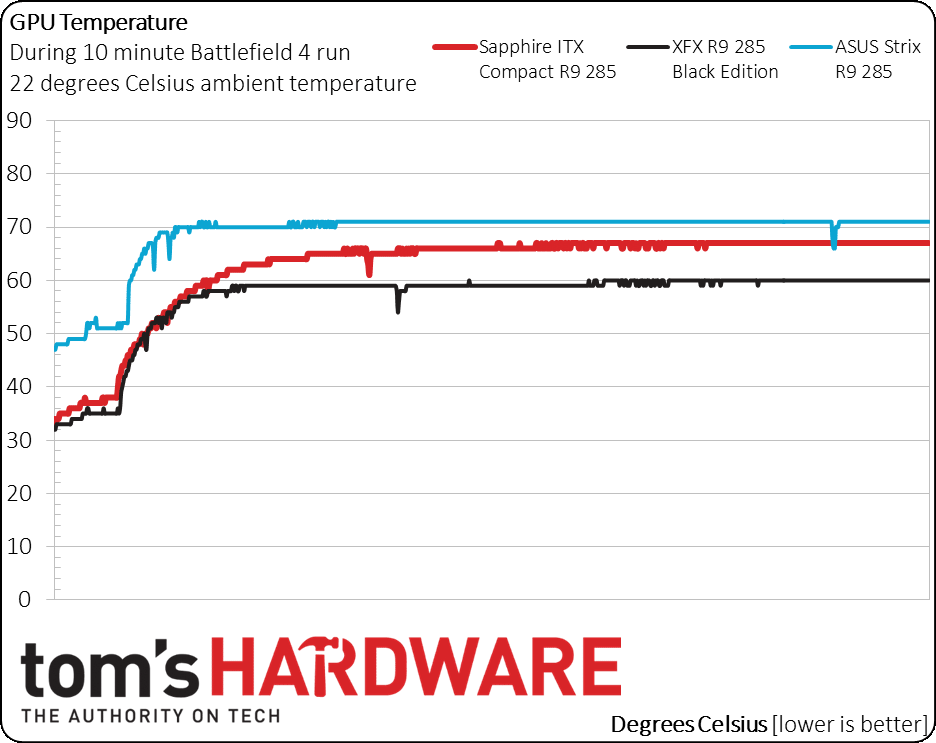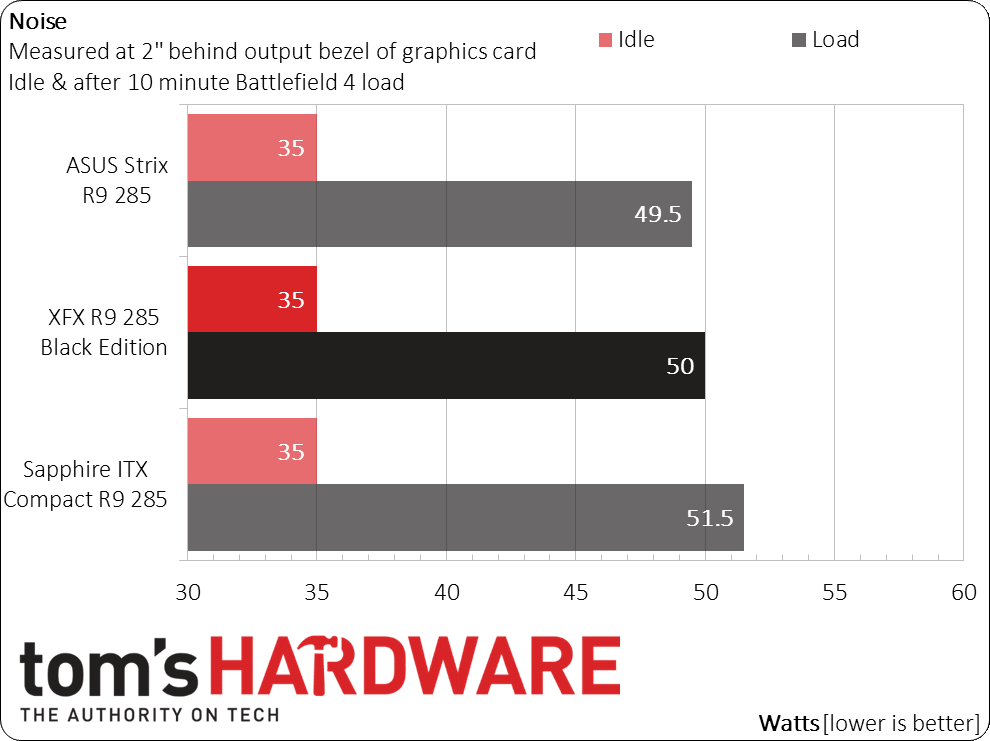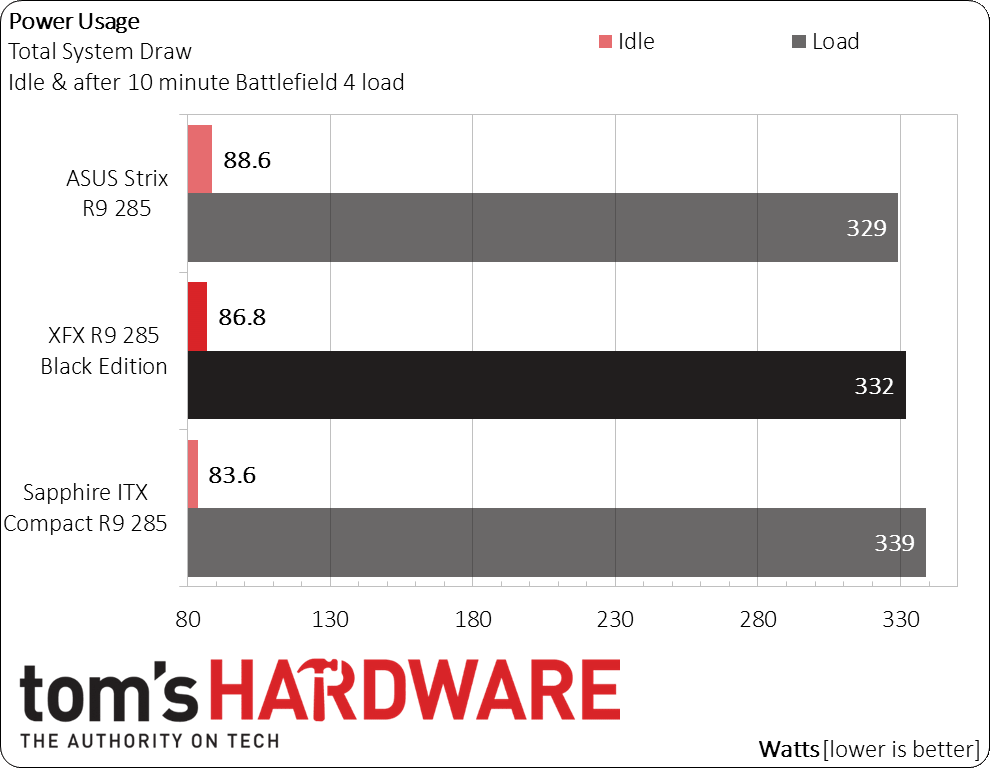XFX Radeon R9 285 Black Edition Review: Maximum Overdrive
Why you can trust Tom's Hardware
Temperature, Noise And Power Benchmarks
Load Temperature
XFX claims that its Double Dissipation cooler is up to 13dB quieter and seven degrees cooler than the competition. Naturally, we want to test those claims.
After a 10-minute Battlefield 4 torture test using the Ultra quality preset, XFX's temperature claim is undeniably vindicated. It tops out about 11 degrees cooler than Asus' Strix and eight degrees cooler than Sapphire's ITX Compact card. Under this heavy rendering load, XFX's card remains under 60 degrees at all times. Very impressive!
Of course, low temperatures aren't impressive if they're enabled by fast-spinning fans generating tons of noise. How are the XFX card's acoustics?
Acoustics
In order to narrow our focus on graphics card acoustics, we stop all of the system's fans during our measurement. The noise level is sampled two inches from the card's I/O bracket. Our chart starts at 30dB, which is roughly what we consider to be completely silent in a home setting.
The Radeon R9 285 Black Edition sits on the quiet end of the spectrum, especially considering its thermal performance. But it's nowhere near 13dB quieter than the competition in this particular test, although we don't know the lab conditions that XFX uses to generate its results.
Power
It's cool and it's quiet, but how does XFX's Black Edition compare when it comes to power draw? With the highest overclock, does it use considerably more juice than its competitors?
We begin this chart at 80W, which is the approximate power draw of the system at idle minus the graphics card. Despite its overclocking claim to fame, XFX's product only draws a few more watts than Asus' Strix and a few less than Sapphire's ITX Compact. It's a fine result.
Get Tom's Hardware's best news and in-depth reviews, straight to your inbox.
Current page: Temperature, Noise And Power Benchmarks
Prev Page How We Tested XFX's Radeon R9 285 Black Edition Next Page Overclocking XFX's R9 285 Black EditionDon Woligroski was a former senior hardware editor for Tom's Hardware. He has covered a wide range of PC hardware topics, including CPUs, GPUs, system building, and emerging technologies.
-
Lutfij I love how the pros and cons are now highlighted at the bottom of the newly formed articles.Reply
Kudos Don :) -
logainofhades Even the 280x is a better buy than a 285, right now.Reply
PCPartPicker part list / Price breakdown by merchant
Video Card: Sapphire Radeon R9 280X 3GB Dual-X Video Card ($229.99 @ Amazon)
Total: $229.99
Prices include shipping, taxes, and discounts when availableGenerated by PCPartPicker 2014-12-05 09:58 EST-0500 -
chaosmassive GTX 970 really make other cards look bad to buy...Reply
i not say this card bad though... -
logainofhades If you can afford the GTX 970, it is a great card. Many cannot afford one. An R9 290, @ $60+ less is good, and the 280x @ $100+ less isn't bad either. The card that I think will really shake things up is the GTX 960.Reply -
cleeve Reply14738723 said:These benchmarks are useless without a comparison to different cards.
It does. It compares to other Radeon R9 285s.
We already compared how a stock 285 performs compared to all other cards, we did that at launch as it says in the article. We included a link for those who'd like to refresh their memory. ;)
-
mortsmi7 "2GB is more then enough for 1080p gaming which the card is designed for."Reply
Then you haven't played Wolfenstien on ultra @ 1080p (which is only possible with a 3GB or more card). It's probably more accurate to say that 2GB fits the performance tier of the card. -
Tzn And Gtx 750ti the best card out in the market, price, performance, power consumption wise.Reply -
moshenokoji It depends on what you pay for a card. A 280 may be a better buy if the 285 is $250 and the 280 is $230. But, I grabbed a Power Color R9 285 Turbo Duo on Thanksgiving for $200 with a $20 rebate effectively making it $180. $180 for a card that is similar to the 280 and extremely close to the GTX 770 or as fast as with a small overclock - I'll take that.Reply


